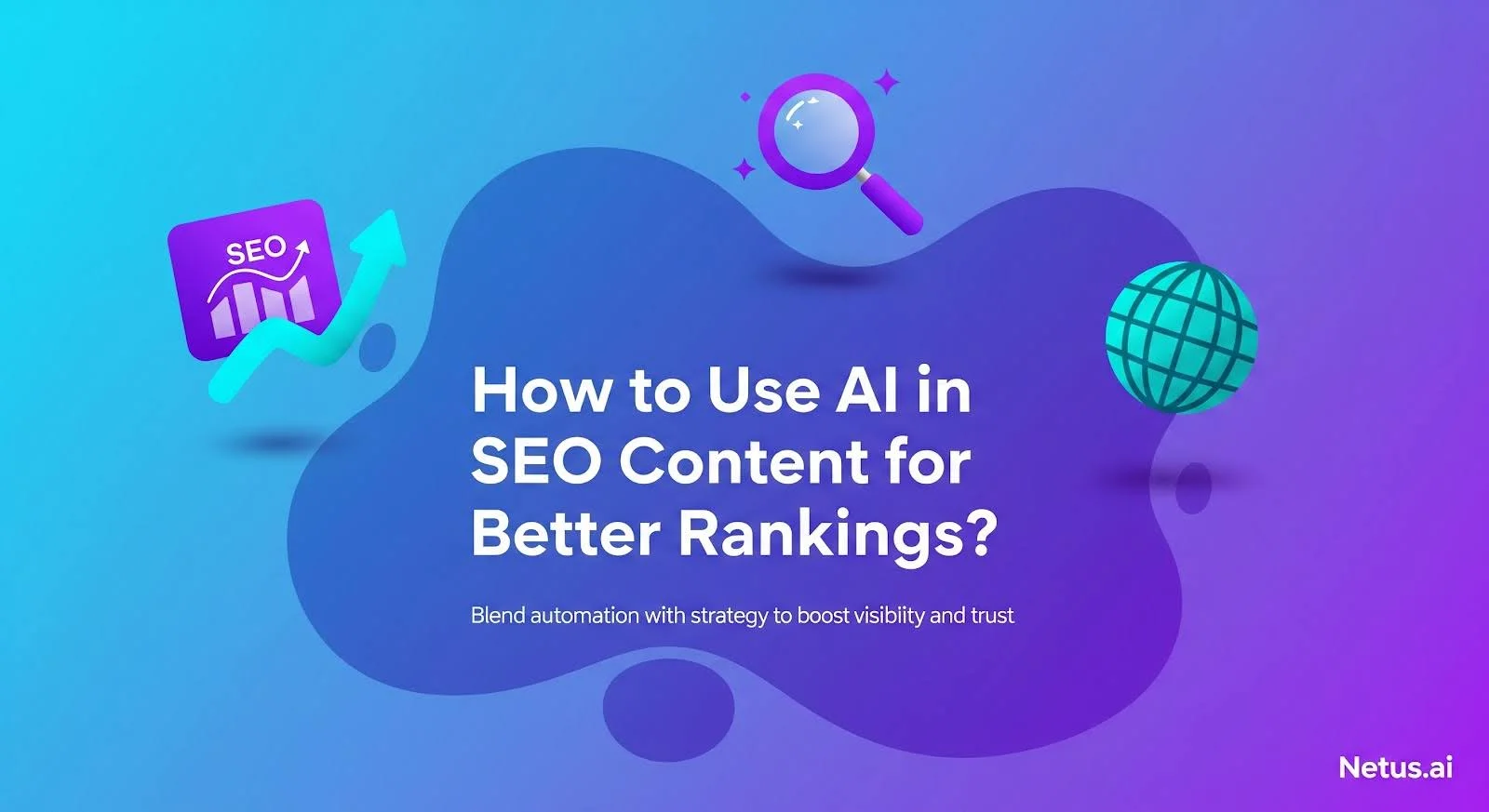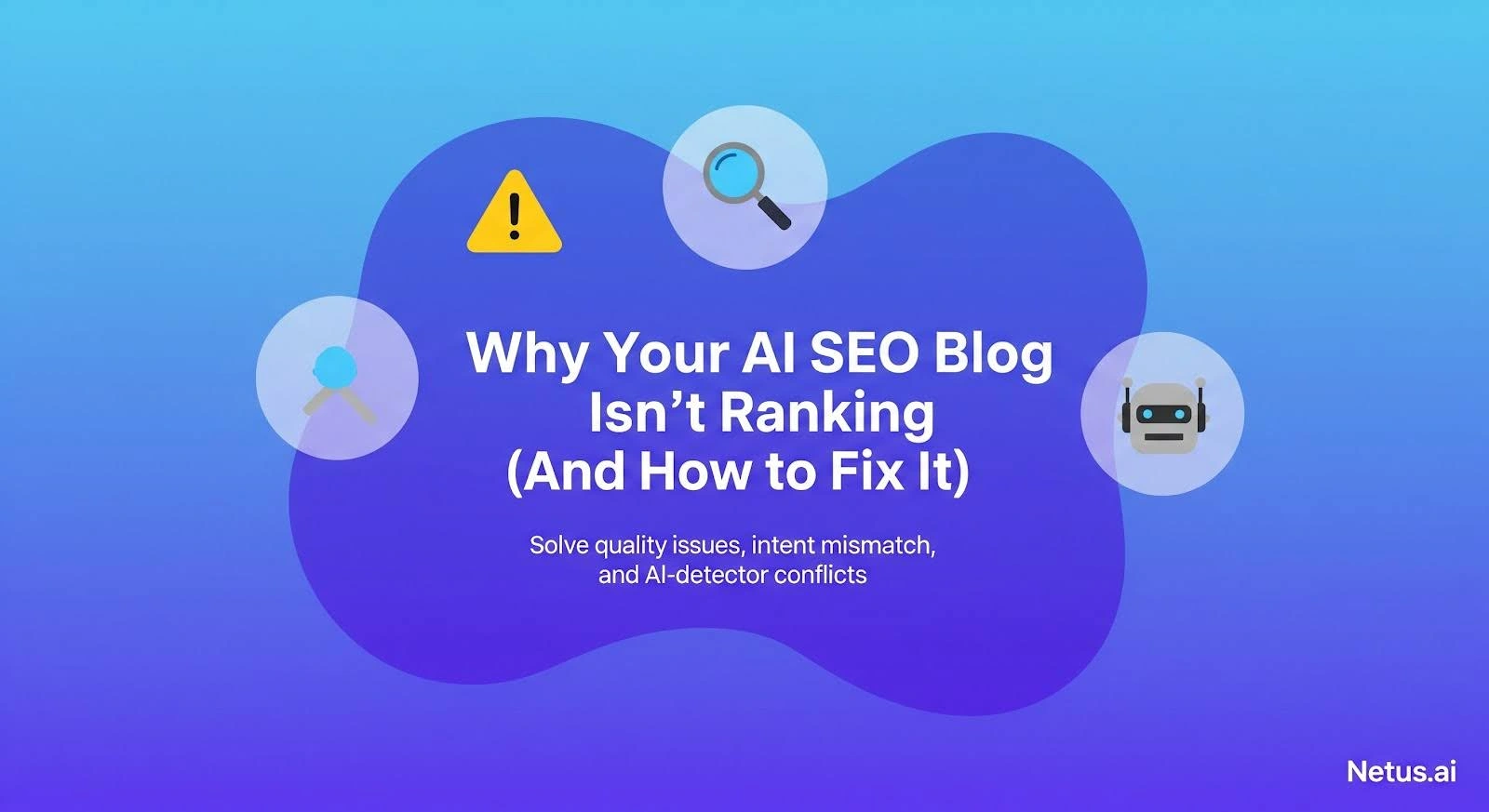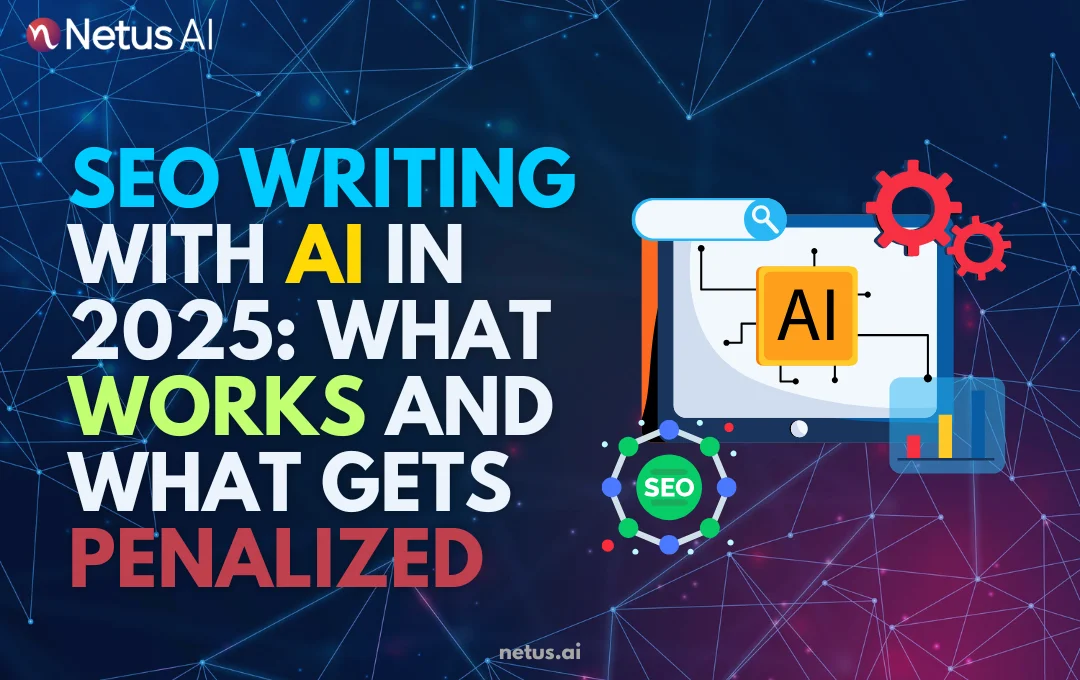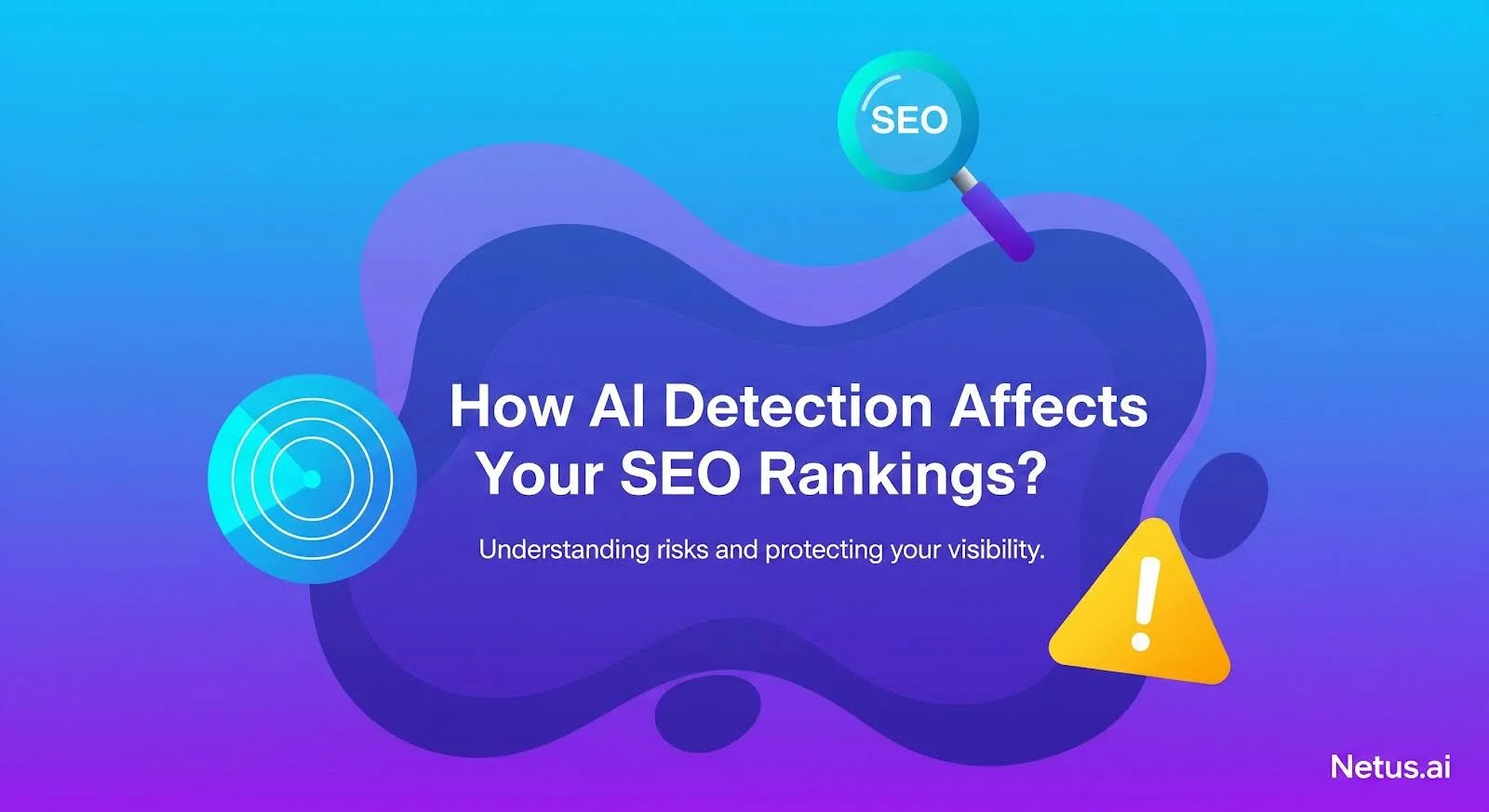AI for SEO content offers appealing scalability, freeing you for strategic tasks.
But then, reality hits. You get an article that’s technically perfect but has all the soul of a spreadsheet. Search engines often ignore generic, machine-generated content. Many identical AI-created pieces go unnoticed, especially for those hoping to use AI for SEO.
Why does your AI content fail (and how to fix it)?
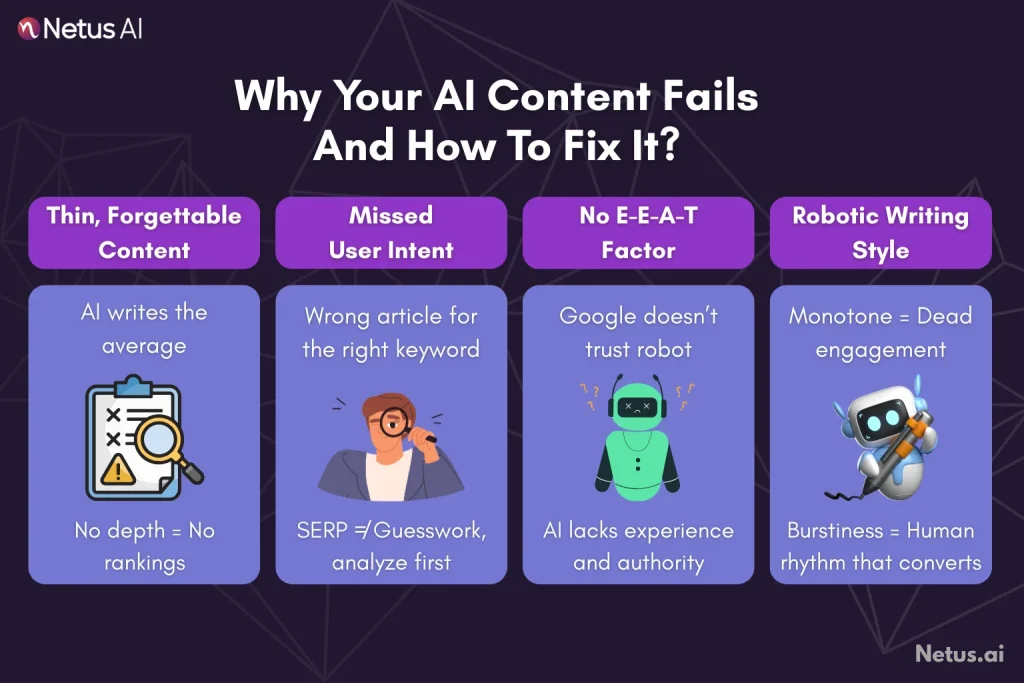
To win the AI in SEO game, you first need to understand why so many people are losing. After dissecting countless failed AI articles, the reasons almost always boil down to three critical mistakes.
Mistake #1: creating "thin content" that Google hates
AI in SEO can be shallow and unoriginal, mirroring Google’s past concerns about low-quality content.
This is a head-on collision with the most important concept in modern SEO: Google’s E-E-A-T guidelines. This framework, Experience, Expertise, Authoritativeness and Trustworthiness, is the very lens through which Google evaluates your site.
Think about it as AI lacks real-world experience, expertise and genuine authority. It cannot be held accountable for its claims, leading to questionable trustworthiness.
Mistake #2: Completely missing the "why" behind the search
E-E-A-T defines good content; search intent explains user searches. Misunderstanding intent, even with strong AI SEO, leads to failure. There are four main user intent types.
- Informational: “How do I?” or “What is?”
- Navigational: “Take me to [Brand Name].”
- Commercial: “What’s the best [Product Type] for me?”
- Transactional: “I want to buy [Specific Product] now.”
AI sees keywords, not user goals. Perform a SERP analysis to understand user intent by examining top-ranking content for your target keyword.
Mistake #3: Sounding Like a Robot
AI generated text can be monotonous and unengaging due to its lack of natural human rhythm.
Look at this:
The Robot: “AI is a helpful tool for content creation. It can be used to write articles. These articles can help with SEO. Businesses should consider using AI.”
The Human: “Let’s be blunt: AI can be a game-changer for your content but only if you command it. Used correctly, it’s a powerhouse for SEO. Used lazily, it’s just a machine for producing noise.”
Engaging content boosts reader interest, reducing bounce rates and increasing dwell time. This signals helpfulness to Google, improving search rankings.
The 5-Phase framework for AI content that actually ranks
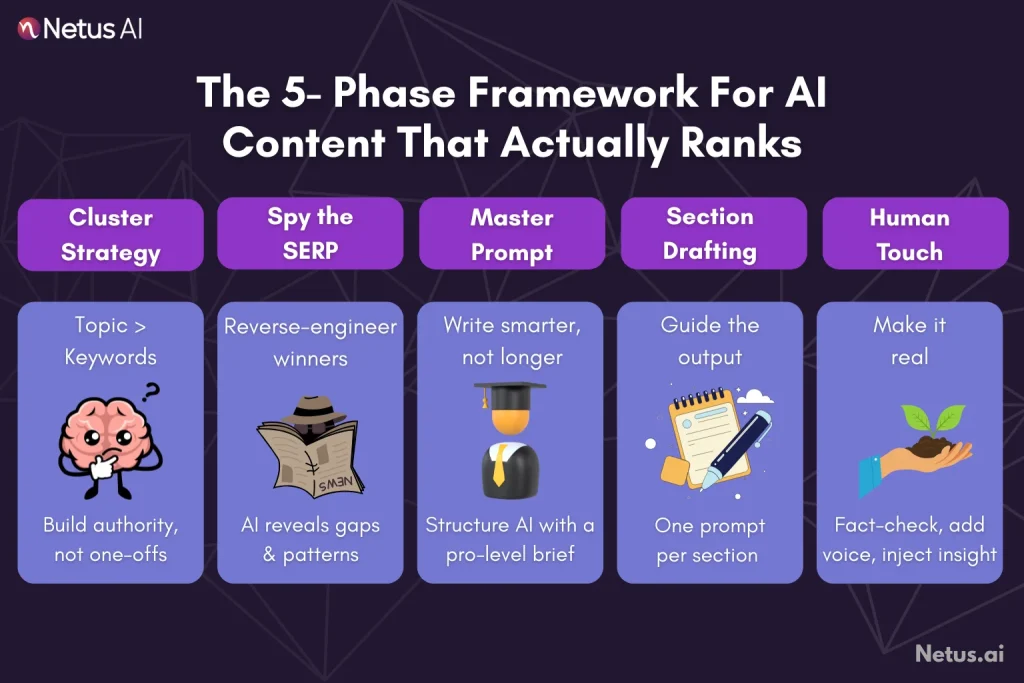
Enough with the problems. Let’s get to the solution. This is the strategic workflow to turn AI in SEO from a liability into your most powerful asset.
Phase 1: Brainstorming topic clusters, not just keywords
Forget hunting for one-off keywords. To win, you need topical authority. You need to own a subject. AI for SEO is a brilliant partner for this kind of high-level strategy.
Actionable prompt example: “act as a senior seo strategist for a brand that sells high-end coffee beans online. Our main pillar topic is ‘french press coffee.’
Generate a complete topic cluster strategy. I need:
- 5 Supporting ‘cluster’ ideas for core blog posts (e.g., ‘the ultimate guide to grind size,’ ‘mastering water temperature’).
- 5 Specific, question-based keywords for faq-style posts (e.g., ‘why is my french press coffee so bitter?’).
- 3 ‘Ultimate Guide’ concepts that can become cornerstone content on our site.
This is for building our pillar content strategy.”
This prompt gives you a content roadmap for an entire quarter, not just a single blog post.
Phase 2: Using AI for competitive reconnaissance
Never write blind. Before you create anything, you need to know what you’re up against. AI for SEO can act as your personal intelligence agent, x-raying the top-ranking articles for you.
Actionable prompt example: “You are a top-tier SEO analyst. I’m giving you the text from the #1 ranking article for ‘how to make french press coffee.’
Your mission is to:
- Extract the exact H2 and H3 heading structure.
- Summarize the 5 key points the article makes.
- Identify 3 ‘content gaps’, what did they miss? What could be explained better?
Here is the text: [Paste the full article text here]”
Do this for the top 3-5 results and you’ll have a crystal-clear blueprint of what it takes to win and how to do it better.
Phase 3: Crafting the "master prompt"
This is where you combine your research into a single, powerful command. A great prompt for AI in SEO is the difference between a masterpiece and a mess.
The “master prompt” template:
- 1. Your Role: “Act as a world-class expert on [Your Topic] and an SEO content writer for a savvy audience.”
- 2. The Reader: “You’re writing for [Describe your audience]. Their biggest frustration is [Describe their pain point]. They want a solution that feels [Describe the desired feeling, e.g., ‘simple and empowering’].”
- 3. The Voice: “Your tone is [Choose 3 adjectives, e.g., ‘confident, clear and encouraging’].”
- 4. The Keywords: “Primary keyword: ‘[Your Keyword]’. Also include: ‘[List related terms]’.”
- 5. The Strategy: “The competition covers [List essential topics]. We will win by also covering these gaps: [List your unique angles].”
- 6. The Task: “Generate a detailed outline for a 2500-word article titled ‘[Your Title]’. Give me a strong hook, at least 6 H2s and specific H3s or bullet points under each.”
This isn’t just a request; it’s a creative brief. It’s how you get a strategic blog post structure, not just a list of ideas.
Phase 4: Guiding the first draft, section by section
Pro tip: Never ask an AI to write a 3,000-word article in one go. You’ll lose control. Instead, work in chunks, guiding the AI in SEO through your outline one section at a time.
Actionable prompt example:
Write an H2 section: ‘De-Mystifying Down Payments: How Much Do You Really Need?’ using the master prompt’s context.
Make sure you cover these H3s:
- Why the 20% ‘rule’ is a myth.
- Low down payment options (FHA, VA loans).
- The truth about Private Mortgage Insurance (PMI).”
This keeps you in the editor’s chair throughout the content generation workflow.
Phase 5: The human touch, where the magic happens
This is the final, most crucial step. You have a solid draft. Now, you must make it human. This is what separates winning content from the noise.
When using AI for content, always fact-check, include personal experiences and cite experts to build credibility. Read aloud for flow and maintain journalistic ethics.
SEO safe content starts at generation: NetusAI’s SEO article writer
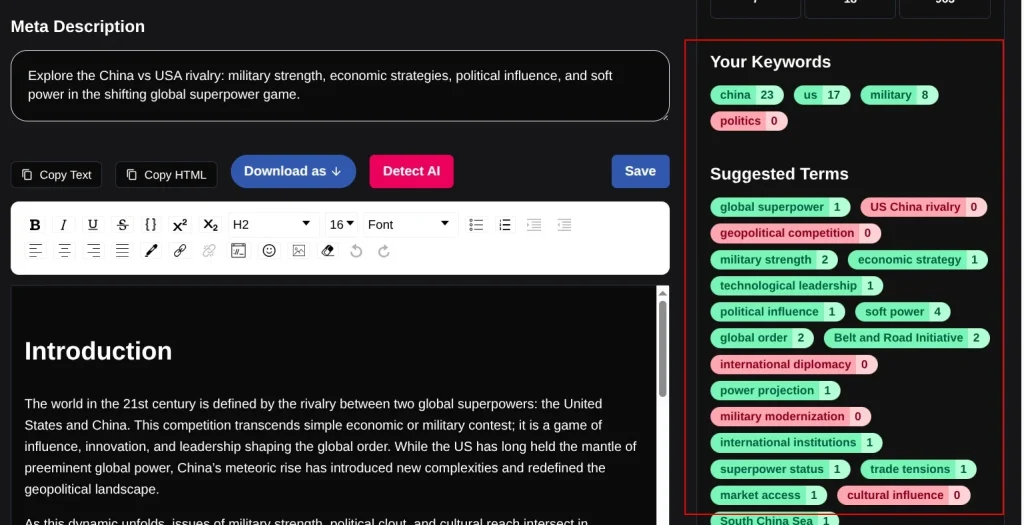
Avoiding stylometry and detection issues shouldn’t begin after content is written, it should start with the writing itself. That’s where NetusAI steps in.
The NetusAI SEO Article Generator creates optimized, full-length blog posts, unlike generic AI tools producing robotic content. Unlike generic tools, it goes beyond simple drafting. It:
- Lets you input headlines and targeted SEO keywords
- Supports long-form templates for full blogs
- Auto-generates a structure with Title → Outline → Content
- Works in multiple languages for global teams
It integrates with the Netus AI Bypasser + Detector system, ensuring undetectable and readable output.
You can generate, review and rewrite all in one interface without needing third-party tools to patch the gaps. Designed for marketers, freelancers and bloggers, it helps AI generated SEO content appear human-written.
NetusAI saves time and improves SEO articles without sacrificing trust or quality.
Final Thoughts
AI won’t replace SEO. But it will replace SEOs who don’t adapt. AI helps SEO by speeding up research, clarifying rewrites and creating undetectable, high-ranking content.
Platforms like NetusAI make that process seamless:
- Write smarter with the SEO Article Generator
- Rewrite safely using the AI Bypasser
- Check risk levels instantly with built-in AI Detection
Whether you’re optimizing product pages, writing long-form blogs or scaling content for a niche site, it’s not about using more AI. It’s about using AI in SEO the right way.
FAQs
Use AI for initial content research, outlines, headings and drafts. Refine with human editing and tools like NetusAI for safe rewriting and to make content undetectable.
Yes, if it meets Google’s helpful content standards. NetusAI helps ensure AI content reads naturally and passes detection.
Definitely. AI detectors can flag your work even if it’s good. Tools like NetusAI’s AI Bypasser are essential for restructuring and humanizing content to avoid penalties.
Use AI as an SEO content assistant for planning, outlining and drafting. Refine and fact-check AI generated content.
Common AI content mistakes: thin content (violates E-E-A-T), missing user intent and robotic tone (high bounce rates).
Follow a 5-step plan: Brainstorm topics, research competitors, create a main prompt, draft sections and refine with human input.
Good AI SEO tools do more than just write text. They help with keywords, headlines, long articles and organizing content. They can also rewrite text to avoid detection and have built-in AI detection.
NetusAI offers an SEO tool designed to enhance blog posts. It achieves this by generating high-quality, undetectable AI content and includes both a bypasser and a detector.

